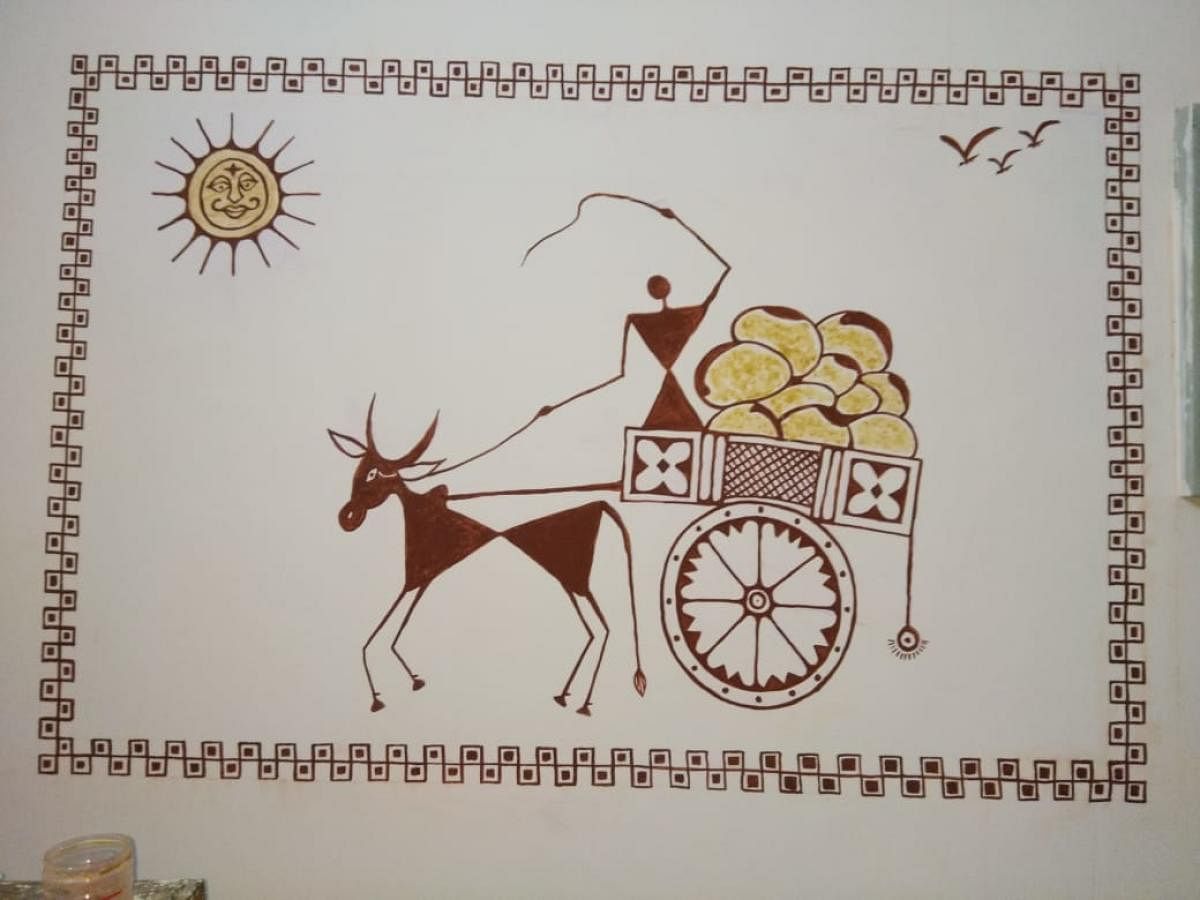In a small home, two girls adorn themselves in front of the mirror and one deduces that they are preparing to go out. The creepered-compound wall around the house is no less beautiful. Outside, there are a few kids playing next to the well, where two women are drawing water. These images give one the picture of holiday mood in the village. The mood is true but not in a real sense.
The everyday scenes of Malnad come alive with minute details in an art form called Hase Chittara, drawn on the walls of rural houses in Sagar taluk.
Traditional decor
Hase Chittara is a folk art form, which is alive even today in the villages in Sagar, Sirsi, Siddapur and Hosanagar belt of Malnad. The art form is mainly nurtured by the Divaru community.
The Hase Chittara form of painting uses natural colours and is classified into three types based on the colours used. If red earth (kemmannu) is used, then it is called Kempu Hase (Kannada word for red painting). If charcoal is used, it is Kappu Hase (black painting) and if rice flour is used, it is Bili Hase (white painting).
Apart from this, natural colours made from turmeric, milk, lime and vegetables are used for added attraction. Brushes made out of grass and natural fibres are used for drawing the images. However, the younger generation makes use of paint brushes available in the market for giving it a fine touch. Hase Chittara is made up of geometric patterns like circles, triangles, squares and lines. But the most interesting part of the art is its detailed real-life scenes.
In the earlier days, walls used to be plastered with cow dung and simple patterns would be drawn to beautify these walls. Now, however, Hase Chittara designs adorn the walls mostly during weddings at home. Gradually, joint families are vanishing and the old mud houses are being replaced by fragmented, smaller concrete houses. In spite of all these developments, a few young artists have kept this art form alive.
Change is key to the survival of an art form and so has Hase Chittara evolved over the years. The paintings on the walls have now been incorporated on the canvas. Radhakrishna Bandagadde of Sagar is one of the prominent artists among those who have been experimenting with this art form while keeping its basic rules intact.
“We grew up seeing this vibrant art on the walls of our houses. I left Sagar for further studies but when I returned, it was sad to see only concrete houses which lacked creativity. The Hase designs had vanished from our walls. I felt that our land had lost its roots owing to urbanisation. However, I was happy to see women making the Hase designs on bamboo baskets for ‘Bhumi Hunnime’. Inspired, I was determined to preserve this art,” he says.
He adds that he learnt the art and began experimenting with it. Radhakrishna worked with various organisations and universities trying to expand its reach and explore the possibilities. And that is how the idea of making Hase decoratives evolved. Then he came in contact with various artists from across the globe through the internet and began exchanging information.
He incorporated geometric patterns from the art of Mexican and African communities along with the traditional Hase Chittara designs. Today, many students are learning this art from him and he conducts Hase Chittara workshops twice a year. He has already trained more than 1,000 students in making Hase Chittara on walls, canvas and cards.
Better exposure
“Warli painting of Maharashtra is similar to our Hase Chittara art. Just like us, the communities around Dahanu and the surrounding region of Thane district have begun aggressively marketing Warli art and that is commendable. Their efforts have resulted in an increased demand for Warli artists. There is demand for interior designing using Hase Chittara in the urban areas also but due to lack of communication and smart marketing, it is lagging. Recognising the rural talent and creating a suitable market for them is important. I wish to see smiles on the faces of the artists, who completely depend on Hase Chittara,’’ says Radhakrishna.
Radhakrishna’s students have also been actively involved in training the next generation in the art form. Prashanti U Kumar, an ex student, runs Kalaniketana art class in Sagara, which has trained about 15 students in the art form. And, there are a few more experts in and around Sagara who train people in the traditional Hase Chittara.
How have the traditional artists perceived Radhakrishna’s experiments? ‘‘Well, there are a few who term this as a remix. The traditional Hase contains limited patterns like birds, animals and houses, he has drawn inspirations from other traditional art forms which resemble Hase Chittara, and increased the number of patterns available. This is something the traditional Hase artists don’t like,’’ says Prashanti. While Radhakrishna says, ‘‘Nothing is permanent but change.”
(Translated by Divyashri Mudakavi)
